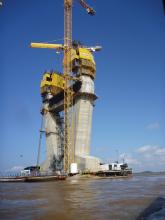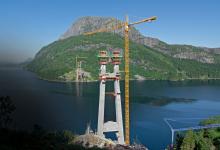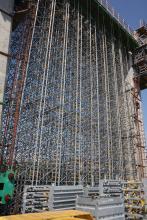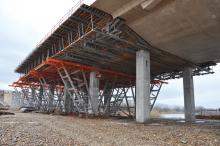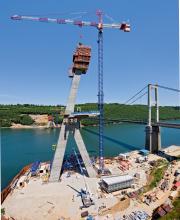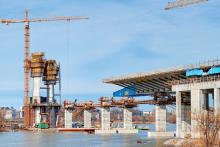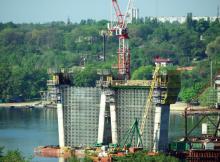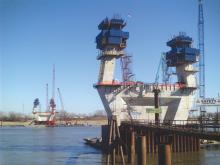Taking a road and rail link across one of the biggest rivers in South America, together with its swamps and flood-plain, called for a new crossing of truly superlative dimensions.
Two 135.5m pylons for the third bridge across the Orinoco River, at Caicara del Orinoco, in Venezuela took shape with a formwork solution and automatic climbing technology from Doka.
The bridge has an overall length of just over 11km and the main bridge is nearly 2.3km long with the roadway 55m above the river. The two ident
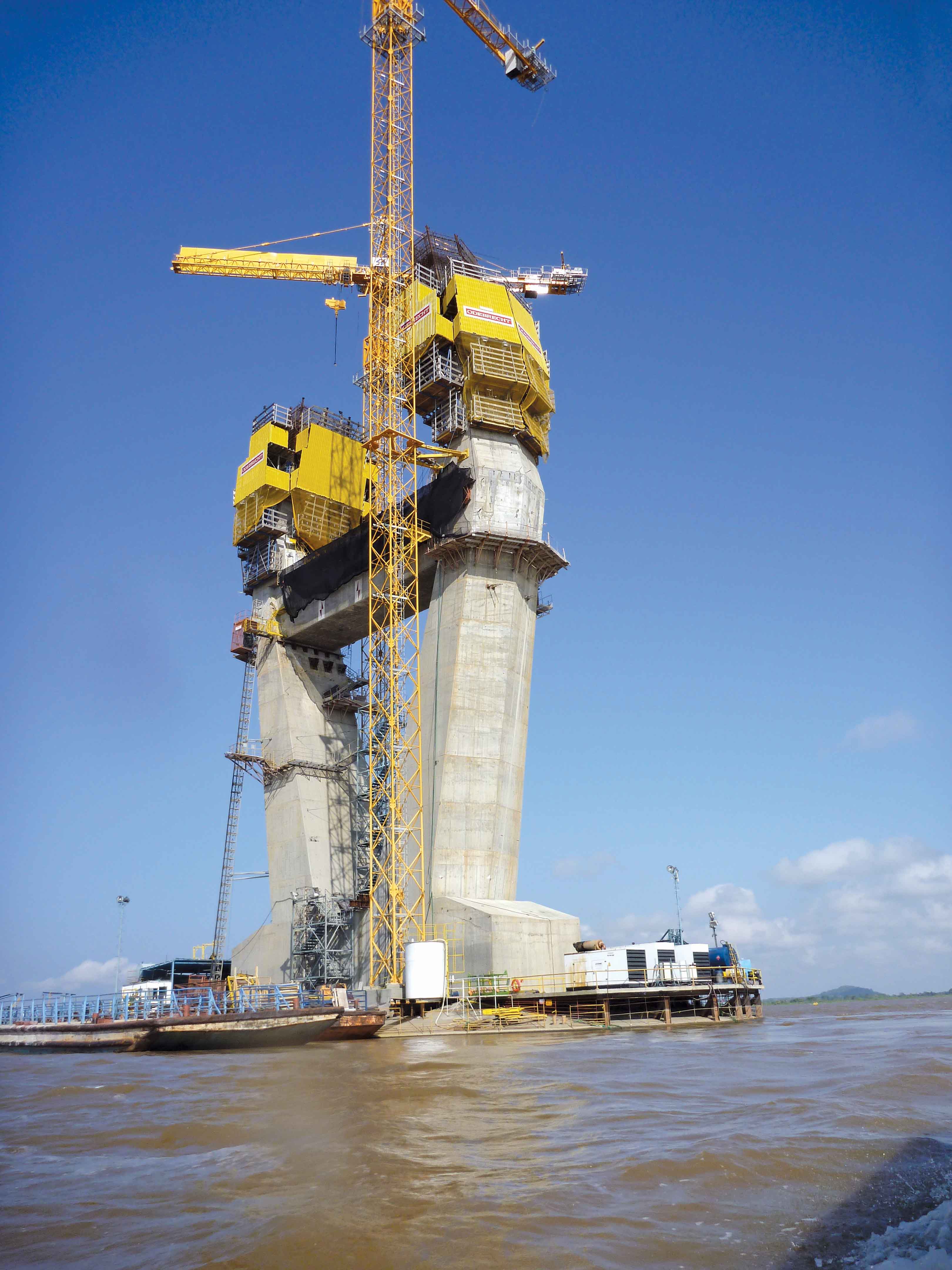
Automatic climbing formwork SKE100 and the versatile large-area formwork Top 50 system met the requirements.
Taking a road and rail link across one of the biggest rivers in South America, together with its swamps and flood-plain, called for a new crossing of truly superlative dimensions.
Two 135.5m pylons for the third bridge across the Orinoco River, at Caicara del Orinoco, in Venezuela took shape with a formwork solution and automatic climbing technology from203 Doka.
The bridge has an overall length of just over 11km and the main bridge is nearly 2.3km long with the roadway 55m above the river. The two identical diamond-shaped pylons of the 360m main span are the centrepiece of this high-capacity road and rail link.
When the contractor1305 Odebrecht first approached Doka Brasil, the forming operations for the south pylon was already nderway. had already commenced. By this time, however, the local crane-jumped formwork originally fielded was no longer suitable.
Doka developed a solution based on the crane-independent automatic climbing formwork SKE100. The 135.5m tall pylons are nearly identical. They incline at an 18° angle below the cross-beam and at 13° above it. The most difficult planning aspects were the changes in the cross-section, the catwalk between the legs of each pylon and the incorporation of an extra suspended platform to provide access to the passenger hoist.
With significant changes in cross-section between the foundations and the cross-beam and a continued upward taper until the point where the pylon-legs meet, the structure geometry demanded a great deal of adaptability from the formwork systems. Automatic climbing formwork SKE100 and the versatile large-area formwork Top 50 system met these requirements without needing time-consuming adaptation work.
The load capacity of 10 tonne per bracket allowed work to proceed simultaneously on several levels. An extra work-deck level was provided above the pouring platform for mounting the reinforcing cages. This allowed the forming and reinforcing operations to run in parallel.
A protection screen was deployed to ensure workplace safety. The working platform and Level +1 were enclosed with trapezoidal sheeting and all other levels safeguarded by standard handrails. A catwalk was the main route for site-traffic between the legs of each pylon. It was attached to the automatic climbers and was raised along with them up to the next section.
An extra – a third – telescopic suspended platform provided access to the passenger hoist.
After around a five-month planning stage, work on pre-assembling the SKE100 units began in September 2011. Doka took over the forming operations on the south pylon from the 17th casting step onward. On the north pylon, Doka automatic climbing technology was used right from the outset. Two sets of automatic climbing formwork SKE100 with 54 units in total, a catwalk and large-area formwork Top 50 were used here. Doka supplied all the systems for on-site pre-assembly and installation.
In the crucial assembly phase, project manager Markus Kamleithner and international formwork instructors were on the site. They gave professional introductory training to the site crew and made sure that the formwork systems were properly assembled, installed and handled. Afterwards a formwork instructor assisted the project team with his technical expertise on-site.
Two 135.5m pylons for the third bridge across the Orinoco River, at Caicara del Orinoco, in Venezuela took shape with a formwork solution and automatic climbing technology from
The bridge has an overall length of just over 11km and the main bridge is nearly 2.3km long with the roadway 55m above the river. The two identical diamond-shaped pylons of the 360m main span are the centrepiece of this high-capacity road and rail link.
When the contractor
Doka developed a solution based on the crane-independent automatic climbing formwork SKE100. The 135.5m tall pylons are nearly identical. They incline at an 18° angle below the cross-beam and at 13° above it. The most difficult planning aspects were the changes in the cross-section, the catwalk between the legs of each pylon and the incorporation of an extra suspended platform to provide access to the passenger hoist.
With significant changes in cross-section between the foundations and the cross-beam and a continued upward taper until the point where the pylon-legs meet, the structure geometry demanded a great deal of adaptability from the formwork systems. Automatic climbing formwork SKE100 and the versatile large-area formwork Top 50 system met these requirements without needing time-consuming adaptation work.
The load capacity of 10 tonne per bracket allowed work to proceed simultaneously on several levels. An extra work-deck level was provided above the pouring platform for mounting the reinforcing cages. This allowed the forming and reinforcing operations to run in parallel.
A protection screen was deployed to ensure workplace safety. The working platform and Level +1 were enclosed with trapezoidal sheeting and all other levels safeguarded by standard handrails. A catwalk was the main route for site-traffic between the legs of each pylon. It was attached to the automatic climbers and was raised along with them up to the next section.
An extra – a third – telescopic suspended platform provided access to the passenger hoist.
After around a five-month planning stage, work on pre-assembling the SKE100 units began in September 2011. Doka took over the forming operations on the south pylon from the 17th casting step onward. On the north pylon, Doka automatic climbing technology was used right from the outset. Two sets of automatic climbing formwork SKE100 with 54 units in total, a catwalk and large-area formwork Top 50 were used here. Doka supplied all the systems for on-site pre-assembly and installation.
In the crucial assembly phase, project manager Markus Kamleithner and international formwork instructors were on the site. They gave professional introductory training to the site crew and made sure that the formwork systems were properly assembled, installed and handled. Afterwards a formwork instructor assisted the project team with his technical expertise on-site.

